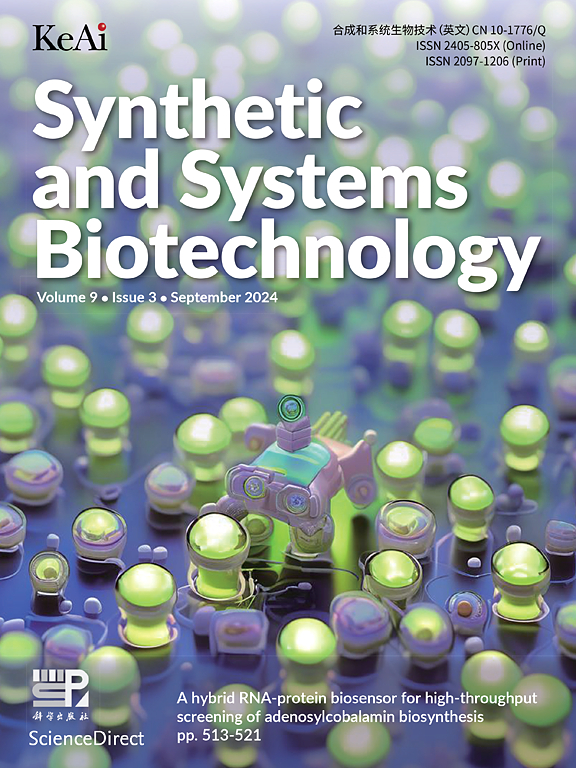Extending dynamic and operational range of the biosensor responding to l-carnitine by directed evolution
IF 4.4
2区 生物学
Q1 BIOTECHNOLOGY & APPLIED MICROBIOLOGY
引用次数: 0
Abstract
l-carnitine is a quaternary amine compound essential for eukaryotic metabolism. It is mainly involved in the oxidative decomposition of medium-and long-chain fatty acids and provides energy for the body. Therefore, it is widely used in health care and food additives. As a pivotal transcriptional activator of l-carnitine metabolism, CaiF is notably activated by crotonobetainyl-CoA, a key intermediate product in the carnitine metabolic pathway. Capitalizing on this mechanism, a sophisticated biosensor was ingeniously developed. Nevertheless, it is worth mentioning that the biosensor currently exhibits a relatively restricted detection range, which results in some specific limitations in practical application scenarios. In this paper, we constructed a biosensor based on CaiF and developed a strategy for modifying this biosensor. The structural configuration of CaiF was formulated by computer-aided design, and the DNA binding site was simulated, which was verified by alanine scanning. Functional Diversity-Oriented Volume-Conservative Substitution Strategy of the key sites of CaiF was conducted to extend the dynamic range of the biosensor. The biosensor based on CaiFY47W/R89A, which exhibited a considerably expanded concentration response range, from 10−4 mM–10 mM, was obtained. The response range was 1000-fold wider and the output signal intensity was 3.3-fold higher to that of the control biosensor. These variants may have great value in improving the l-carnitine production process.
通过定向进化扩展生物传感器响应左旋肉碱的动态和操作范围
左旋肉碱是真核生物代谢所必需的季胺化合物。主要参与中、长链脂肪酸的氧化分解,为机体提供能量。因此,它被广泛应用于保健和食品添加剂。作为左旋肉碱代谢的关键转录激活因子,CaiF主要被左旋肉碱代谢途径的关键中间产物crotonobetainyl-CoA激活。利用这一机制,一种复杂的生物传感器被巧妙地开发出来。然而,值得一提的是,目前生物传感器的检测范围相对有限,这在实际应用场景中造成了一些具体的限制。在本文中,我们构建了一个基于caf的生物传感器,并开发了一种修改该生物传感器的策略。通过计算机辅助设计制定CaiF的结构构型,模拟DNA结合位点,并通过丙氨酸扫描进行验证。采用以功能多样性为导向的CaiF关键位点体积保守替代策略,扩展了生物传感器的动态范围。得到了基于CaiFY47W/R89A的生物传感器,其浓度响应范围从10−4 mM - 10 mM显著扩大。与对照生物传感器相比,响应范围宽1000倍,输出信号强度高3.3倍。这些变体可能对改进左旋肉碱的生产工艺有很大的价值。
本文章由计算机程序翻译,如有差异,请以英文原文为准。
求助全文
约1分钟内获得全文
求助全文
来源期刊

Synthetic and Systems Biotechnology
BIOTECHNOLOGY & APPLIED MICROBIOLOGY-
CiteScore
6.90
自引率
12.50%
发文量
90
审稿时长
67 days
期刊介绍:
Synthetic and Systems Biotechnology aims to promote the communication of original research in synthetic and systems biology, with strong emphasis on applications towards biotechnology. This journal is a quarterly peer-reviewed journal led by Editor-in-Chief Lixin Zhang. The journal publishes high-quality research; focusing on integrative approaches to enable the understanding and design of biological systems, and research to develop the application of systems and synthetic biology to natural systems. This journal will publish Articles, Short notes, Methods, Mini Reviews, Commentary and Conference reviews.
 求助内容:
求助内容: 应助结果提醒方式:
应助结果提醒方式:


